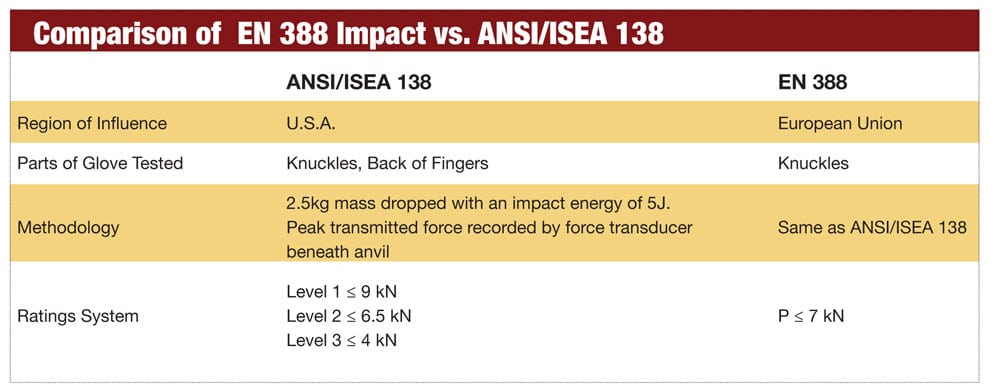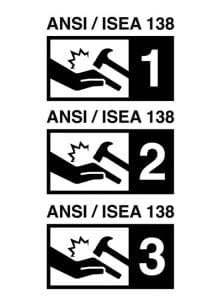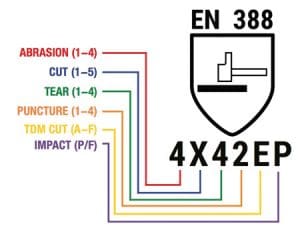Impact resistance the latest frontier in glove technology.
By David Miller
Have you ever noticed that all the meat on your hand is on the front side, while the back of the hand is skin and bones? Almost all the things you can do with your hands use the palm and fingers, while the back of the hand gets employed only when it is time to knock on a door or put up your dukes. When it comes to glove design, it is no wonder that it is the front of the glove that has received most of the attention.
Mechanical Risks
When work gloves first began to be performance rated, testing all focused on the front of the glove. The most closely followed glove properties traditionally have been resistance to abrasion, cuts and puncture. Many work gloves with high ratings in cut resistance or puncture are constructed in such a way that their awesome protective properties only apply to the palm and fingers; the backside of the glove often does not qualify for the cut or puncture rating that the glove displays. For many occupations such as sheet metal or glass installation, the dangers typically attack the protected parts of the glove. But other workers, such as a sorter in an MRF facility, are as likely to get injured in the back of the hand as the front.
I wrote about this more in-depth in a previous article (Fitting the Glove to the Task, Nov. 2016). Although cuts and punctures to the back of the hand are certainly an issue to take seriously, the number one mechanical risk facing the back of the hand for most workers is impact, and the attention of the industrial safety community has lately begun to focus on this as an important safety issue.
Impacts can be caused by a tool or other object unexpectedly striking your hand. Another source of impact could be a hand lifting a heavy object like a trash container, bumping the lip of the garbage truck hopper as the worker wrestles the container into position to dump it. The kinetic energy of the heavy container can transform a harmless bump into a serious hand injury when the hand is caught between 35 pounds of trash and the unyielding lip.
Mechanic’s gloves have traditionally featured dorsal padding to mitigate these mishaps. More recently, there has been a proliferation of work gloves of all pedigrees featuring bumpers on the back of the hand to add impact protection on top of whatever else the glove was designed to do. These bumpers are fashioned out of a variety of rubbery materials with differing degrees of effectiveness.
As we have seen with other critical protective features in gloves, there comes a point when the industry cries out for a referee to step in and help us understand which models are most effective amongst the many choices in the marketplace. For impact protection, that moment has finally come.

A New Standard
Safety managers in the U.S. can look forward to the imminent release of ANSI/ISEA 138, which is due to publish a voluntary standard quantifying effectiveness of impact protection in gloves.
Manufacturers wishing to submit their gloves for testing will send them to an independent lab. The lab will test knuckles and fingers on the specified equipment, and the lowest rated section of the glove will determine the overall rating of the glove.

The test results are categorized as performance level 1, 2, or 3, with 3 being the highest level of protection. A glove that achieves even a level 1 rating indicates that it provides more impact protection than your average work glove. There are no “participation trophies” given out under ANSI/ISEA 138, and a glove that scores any of the three levels of protection will bear that score on a permanent label prescribed in the standard.
By comparison, the standards entity serving the European Union added impact protection to its EN 388 standard of mechanical risk ratings in 2016. Even though EN 388 has no jurisdiction in the U.S., its ubiquitous hammer within a shield label appears on so many gloves sold in the U.S. that it has become familiar to American safety managers, who take full advantage of the information the label displays.
The familiar label originally featured a four-digit code along with the logo, with each number representing the mechanical risk rating for abrasion, cut, tear and puncture. With the 2016 revision, the code is now expanded to six digits, with the fifth representing an alternative cut level test and the sixth reserved for the impact rating of the glove. We are just now beginning to see the extra digits appear on gloves in the marketplace.
There are similarities and differences between the EN 388 impact ratings and those of ANSI/ISEA 138. The test equipment and methodology are exactly the same in both tests, but it is important to note that the EN 388 test applies only to knuckles rather than knuckles and fingers.

There is also a difference in the scoring; whereas the ANSI/ISEA sorts the test results into three levels of effectiveness, the EN 388 score is shown as P for pass and F for fail. A P-rated glove would be roughly equivalent to a level 2 or better on the American scale, except we cannot say that for sure since EN 388 only tests knuckles and ANSI/ISEA scores reflect the lowest result of test areas, which include knuckles and fingers.
Level of Impact
So, what is an acceptable level of impact protection for the waste industry? Of course, it depends on the job. For some tasks, impact protection is going to be quite low on the list of priorities. For haulers, however, there is plenty of justification for requiring level 1 or 2 impact protection, perhaps even level 3 if the equipment and job assignment require a lot of exertion or pushing, lifting or pulling of levers and loads that have a tendency to give way unexpectedly. It is never a bad idea to talk it over with your glove supplier. A knowledgeable supplier can recommend gloves that best fit your situation for the best value.
David Miller is the Waste Industry Manager for HUB Industrial Supply (Lake City, FL). He is a Certified Safety Professional and works with managers to effectively implement and manage PPE and MRO programs in the waste industry. He may be reached at [email protected]. HUB Industrial Supply is an Applied MSSSM company.
You may also like:
The Right Fit: Finding the Correct Gloves for Your Application
